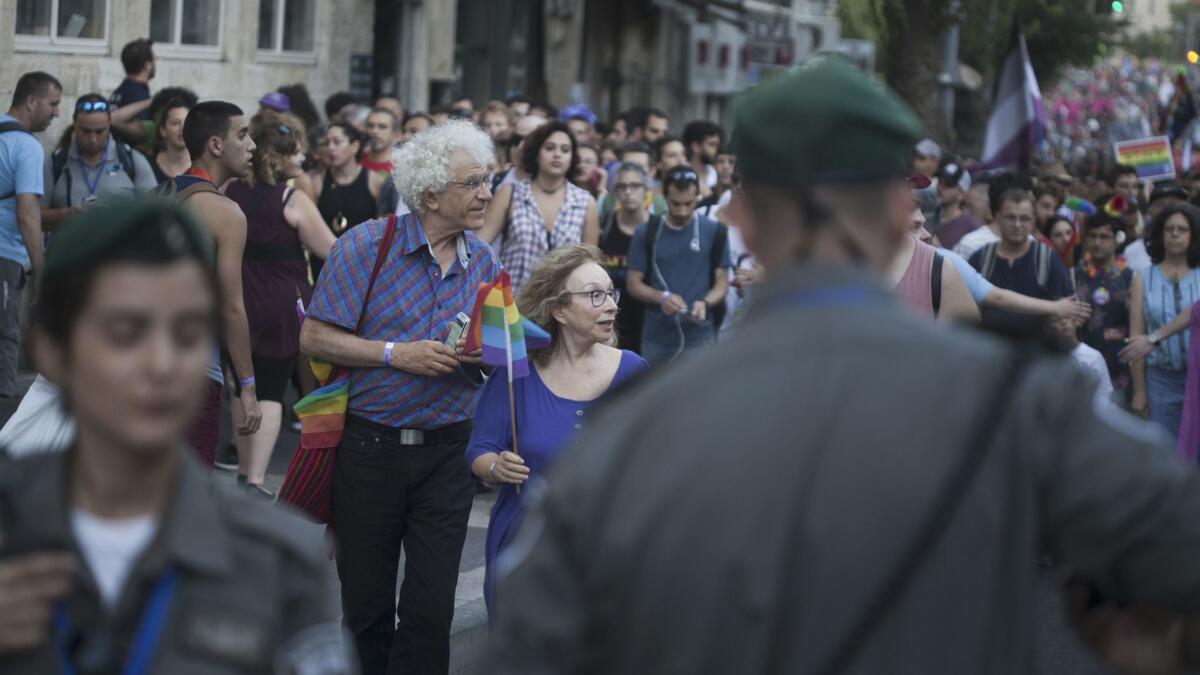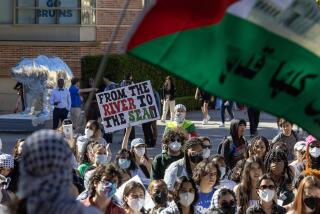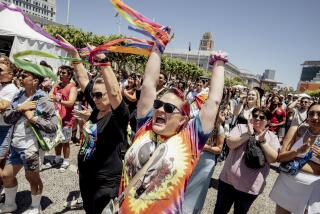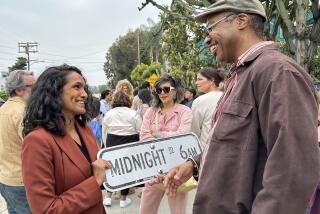Celebration, sorrow and arrests at annual gay pride march in Jerusalem
Reporting from Jerusalem — At Jerusalem’s Liberty Bell Park, a nine-acre green space created in 1976 in tribute to the American people, “bears” gathered around a flag of variegated earth tones stamped with a bear paw and distributed fliers that posed the question, “Who are we?”
A pamphlet in Hebrew and English explained that “in male gay culture, a bear is often a larger, hairier man who projects a masculine image.”
For the record:
12:22 a.m. Aug. 24, 2019This article incorrectly states that a man who killed a girl at the 2015 parade was recently released on parole. The assailant is still in prison, serving a life sentence.
Nadav Knossow, 39, a PhD candidate in desert soil microbiology who wrote the text, said the message was necessary because, “otherwise, everyone comes up to me and asks, ‘What’s that flag with the wrong colors?’”
Together with Adam Stovicek, 29, a fellow doctoral student from Ben-Gurion University, and his partner, Doron Rosenthal, also 29, a Shenkar College student of industrial design, they made a friendly pack.
It was Stovicek’s fifth Israeli gay pride parade. He referred to himself as “an experienced native prider.”
Every year at the pride march, there is a significant police presence. There was no difference at this year’s, held Thursday. At least 22 protesters were arrested, among them one carrying a knife — a painful reminder of Shira Banki, a 16-year-old girl who was stabbed to death at the gay pride march in 2015. The assailant, who stabbed three people in all at the parade, was recently released on parole.
The Israeli daily newspaper Haaretz said 22,000 people paraded past Jerusalem’s Great Synagogue on King George V Street and left white flowers at an informal memorial to honor Shira.
But Israeli police said about 12,000 marchers paraded around the streets of the Holy City, a mile from the Temple Mount, where Orthodox Jews and devout Muslims — who call the site Al Aqsa Mosque — have long been in conflict.
Avi Mayer, spokesman for the Jewish Agency, tweeted from a drag show and party the night before the parade that with “religious Jews in kippot and religious Muslims in hijabs, Jerusalem [is] more complex than you might imagine.”
Guy Frenkel, 34, an international relations specialist visiting from North Brunswick, N.J., said, “In an age where homophobia is becoming OK again, it’s important to show solidarity. It’s not just Jerusalem. Even in New York in the age of Trump you can get your ass kicked. It’s happened in Hell’s Kitchen, in Manhattan.”
Stovicek was glad the 2017 parade was “a bit more cheerful than last year’s. But still, you know, it’s very somber. We carried flowers to a girl’s memorial site.”
But Rosenthal, remarking on the many families with young children parading down the street (many babies had stickers that read “I love” stuck onto their onesies), said, “This is a pleasant, carefree parade when you compare it to the Mardi Gras carnival vibe in Tel Aviv. That is more about display than marching in solidarity with rights and identity. This is very relaxed.”
He chuckled at the “idiot picketers,” a tiny clutch of four or five men, who had stood at a well-policed corner chanting, “Jerusalem is not Sodom!”
The picketers were not wrong. Mt. Sodom is 80 miles away from Jerusalem, in the Judean desert.

Tarnopolsky is a special correspondent.
More to Read
Sign up for Essential California
The most important California stories and recommendations in your inbox every morning.
You may occasionally receive promotional content from the Los Angeles Times.










